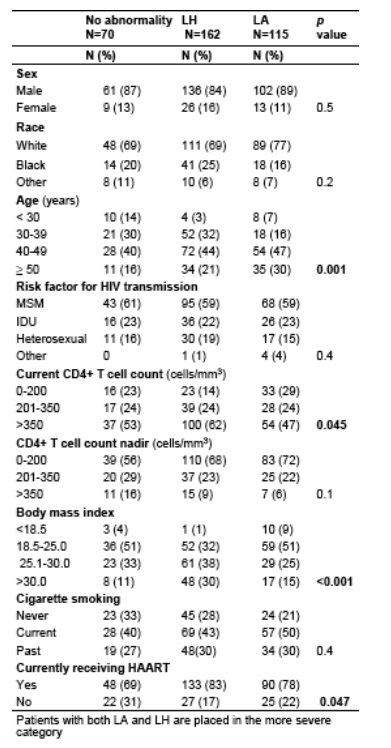 |
 |
 |
| |
Lipoatrophy and lipohypertrophy are independently associated with hypertension (FRAM): the effect of lipoatrophy but not lipohypertrophy on hypertension is independent of obesity
|
| |
| |
Reported by Jules Levin
15th CROI, Feb 2008, Boston
Heidi M. Crane1, MD, MPH, Carl Grunfeld2, MD, PhD, Robert D. Harrington1, MD, and Mari M. Kitahata1, MD, MPH
From theDepartments of Medicine, University of Washington1, Seattle, WA and University of California2, San Francisco, CA
Background
Lipoatrophy (LA) and lipohypertrophy (LH) are associated with metabolic abnormalities, but little is known about their impact on hypertension
Prior studies have been small, yielded conflicting findings, and did not examine LA and LH separately
We conducted this study to examine the independent association between LA and LH with hypertension among HIV-infected patients
Strengths and limitations
The FRAM measure allowed us to examine the strength of the relationship between hypertension and LA severity separately from LH severity
The observational cross-sectional study design demonstrates a significant association between LA and LH and hypertension but does not provide evidence of causality
Conclusions
We found that LA and LH are significantly associated with hypertension among patients in routine HIV care
Our findings suggest that the association between LH and hypertension may be mediated via BMI, but that LA is associated with hypertension independent of BMI
There is a dose response effect with more severe body morphology abnormalities associated with greater risk of hypertension
Self-reported measures of LA and LH are associated with clinical outcomes such as hypertension with potential long-term cardiovascular implications
Results
347 patients enrolled with a total of 2,278 BP readings (Table 1)
Body morphology: no abnormality in 70 (20%) patients
--137 (39%) with mild LH and 25 (7%) with moderate LH
--101 (29%) with mild LA and 14 (4%) with moderate LA
Hypertension-125 patients (35%) had hypertension
--105 with a clinical diagnosis of hypertension
--36 with mean SBP >140 mmHg
--27 with mean DBP >90 mmHg
In adjusted analyses, patients reporting any degree of LA were more than twice as likely to have hypertension compared with patients reporting no abnormalities (OR 2.2; p=0.04), as were patients with any degree of LH (OR 2.5; p=0.01)
Additional adjusted analyses were conducted to examine the association with body morphology severity (Table 2)
--patients with moderate LH were 4 times as likely to have hypertension (OR 4.3; p<0.01) as patients without abnormalities
--patients with moderate LA were 4 times as likely to have hypertension (OR 4.3; p=0.03) as patients without abnormalities
--patients with mild LH were twice as likely to have hypertension (OR 2.3; p=0.03) as patients without abnormalities
--patients with mild LA were twice as likely to have hypertension, however this difference was not statistically significant
--Older age and higher current CD4+ cell count were also associated with increased risk of hypertension (Table 2)
We hypothesized that the impact of LH on hypertension was mediated, in part, through a higher body mass index (BMI). When BMI was added to the adjusted model, BMI was significantly associated with hypertension (OR=1.1; p<0.001 per kg/m2), and the association between LH and hypertension was no longer present. However, the association between moderate LA and hypertension was present after adjusting for BMI (OR=5.1; p=0.02)
Of note in table 2, adjusted risk for hypertension when 30-40 yrs old is 4.4 compared to less than 30 yrs old.
Table 2. Adjusted odds ratios for factors associated with development of hypertension

Table 1. Clinical and demographic
characteristics of study patients (N=347)

Methods
STUDY SETTING: Cross-sectional study of patients in the University of Washington (UW) HIV Cohort, a longitudinal observational cohort of HIV-infected patients
STUDY SUBJECTS: Convenience sample of patients ≥18 years of age who attended the clinic for a routinely scheduled appointment between 9/26/05 and 1/3/07
DATA SOURCE: Patients used tablet PCs with touch screens to complete an assessment with body morphology (based on the Fat Redistribution and Metabolic Change [FRAM] instrument), smoking status, and illicit drug use
Data were also obtained from the UW HIV Information System (UWHIS) which captures comprehensive clinical data for the UW HIV cohort from 1995 to the present. Demographic, clinical, laboratory, medication, and socioeconomic data are obtained from multiple institutional data systems. Clinical patient data such as blood pressure (BP), height, and weight are routinely collected and integrated in the UWHIS
DEFINITION OF HYPERTENSION: We defined hypertension as a clinical diagnosis of hypertension confirmed by treatment with an antihypertensive medication, or a mean systolic BP >140 mmHg or diastolic BP >90 mmHg within the prior 6 months
BODY MORPHOLOGY: FRAM items for individual body regions were coded on a 7-point scale ranging from -3 to +3. No change was scored as 0, mild, moderate, and severe increases were scored as +1, +2, and +3, and mild, moderate, and severe decreases were scored as -1, -2, and -3. An overall LH score was calculated using all positive responses and an overall LA score was calculated using all negative responses totaled. Severity of each of these conditions was defined as none (0 points), mild (1-12 points), and moderateto-
severe (>12 points)
|
| |
|
 |
 |
|
|